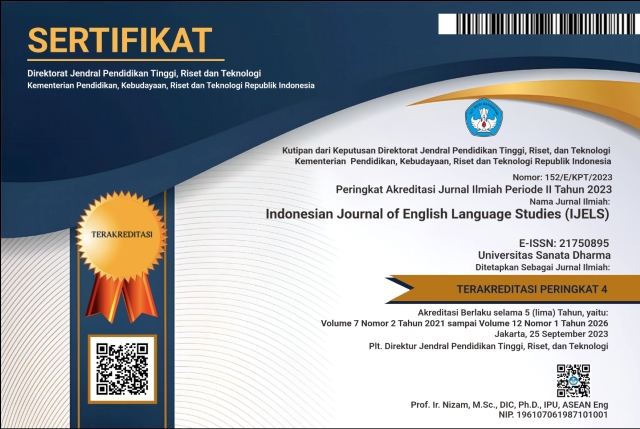Metaphors Stemming from Nature in the Poetry of Mahmoud Darwish
(1) Al-Istiqlal University
(*) Corresponding Author
Abstract
This is a critical paper inspecting metaphors, the most artistic device, in Mahmoud Darwish's poetry. This research classified metaphors into three basic categories: metaphors of trees and plants such as wheat, metaphors of animals and birds such as butterfly, hoopoe, and dove, and metaphors of concrete and abstract natural elements. This study reports the fact that Darwish was brought up in a rural community. His father was a villager who grew crops for being food secure. Consequently, that rural environment affected the poetry of Darwish through metaphors and symbolism. Thus, it can be concluded that these poetic metaphors are a logic outcome of that rural atmosphere.
Keywords
Full Text:
PDFReferences
Al Salem, M. N. (2014). The translation of metaphor from Arabic to English in selected poems of Mahmoud Darwish with a focus on linguistic issues. University of Leeds.
Al-Zubi A (1995). Al sha’erAlghadeb Mahmoud Darwish. Hamada Foundation. Irbid, Jordan.
Asli, C. (2017). Exploring the concepts of “homeland”, “exile” and “return” in the Palestinian poetry through the work of Mahmoud Darwish (Doctoral dissertation).
Baker, M. (2006). Translation and conflict: A narrative account. Routledge, London and New York.
Bassnett, S. (2002). Translation studies (3rd Ed.). Routledge.
Belhadj, H. (2018). Implicature in metaphors a linguistic analysis of metaphorical expressions in Arabic poetry. BA Degree, Faculty of Letters and Humanities, Abdelmalek Essaadi University, Tetouan.
Buruma, I. (2001). The Romance of Exile. New Republic, 224(7), 33-38.
Cameron, L. (2003). Metaphor in educational discourse (advanced in applied linguistics). Bloomsbury Acad., London: Continuum, 306..
Dab. (2005). Arabic poetry. [online] Retrieved from:
http://www.adab.com/en/modules.php?name=Sh3er&doWhat=lsq&shid=1&start=0 –(10 March 2021)
Darwish, M. (1980). The music of human flesh. Trans. by Denys Johnson-Davies. Washington D.C.: Three Continents Press.
Darwish, M. (1994). Psalms. Trans. by Ben Bennani. Colorado: Three Continents Press.
Darwish, M. (2003). Unfortunately, it was paradise. Trans. by Munir Akash and Carolyn Forche. Berkeley - Los Angeles – London: University of California Press.
Darwish, M. (2006). Why did you leave the horse alone? Trans. by Jeffery Sacks. New York: Archipelago Books.
Darwish, M. (2007). The butterfly’s burden. Trans. by Fady Joudah. Northumberland: Bloodaxe Books Limited.
Darwish, M. (2009a). If i were another. Trans. by Fady Joudah. New York: Farrar, Straus and Giroux.
Darwish, M. (2009a). Almond blossoms and beyond. Trans. by Mohammad Shaheen. Massachusetts: Interlink Books.
Darwish, M. (2009c). A river dies of thirst. Trans. by Catherine Cobham. London: Saqi Books.
Darwish, M. (2010a). The state of siege. Trans. by Munir Akash and Daniel Abdal-Hayy Moore. New York: Syracuse University Press.
Darwish, M. (2010b). Absent presence. Trans. by Mohammad Shaheen. London: Hesperus Press Limited.
Doucherty, J.. (2004). Metaphors: Narratives, metaphors, and negotiation.87 Marg. L.Rev. Retrieved from: http://scholarship.law.marquette.edu/mulr/vol87/iss4/22. 5th April 2012.
Fragopoulos, G. (2009). Tracing Mahmoud darwish’s Map. 17.
Hansen, K. (1999). Longman dictionary of contemporary English. Words, Lexemes, Concepts, Approaches to the Lexicon: Studies in Honour of Leonhard Lipka, 85.
Larson, M. L. (1984). Meaning-based translation: A guide to cross-language equivalence (2nd ed.). New York: University press of America.
Månsson, A (2003). Passage to a new wor(l)d: Exile and restoration in Mahmoud Darwish's writings. Doctoral dissertation, Acta Universitatis Upsaliensis.
Masood, K.M. (2020). Manifestations of nature and politics in Mahmoud Darwish’s Metaphors.
Mena, E. (2009). The geography of poetry: Mahmoud Darwish and postnational identity. Journal of Sociology of Self-knowledge, 7, 111-118.
Mohamed, M.T. (2012). The metaphor of nature in the Holy Quran: A critical metaphor analysis. Language in India, 12(11).
Munday, J. (2012). Introducing translation studies: Theories and applications (3rd Ed.), Abingdon: Routledge.
Nader, U. (2010). Mahmoud Darwish, like almond blossoms and beyond (Ka-zahri al-lawzi wa abad) (1941-2008), Translated by Mohammad Shaheen (Northampton, Massachusetts: Interlink Books, 2009). Journal of Arabic Literature, 41(1-2), 196-197.
Newmark, P. (1988). A textbook of translation (Vol. 1). New York: Prentice Hall.
Notopoulos, J. (1944). The Symbolism of the sun and light in the Republic of Plato. Classical Philology, 39(4), 223-240. Retrieved April 7, 2021. Retrieved from http://www.jstor.org/stable/266557
Parmenter, B.M. (1994). Giving voice to stones: Place and identity in Palestinian literature. University of Texas Press.
Raine, K. (2002). Blake and tradition. London: Routledge.
Shtaya, M. (2021). Interview over a phone call on April 18 2021 at 10:00 PM.
Yee, D. (2009). Why did you leave the horse alone? A Book Review by Danny Lee. [Online]. [19 February 2011]. Retrieved from: HTTP:// dannyreviews.com/.
DOI: https://doi.org/10.24071/ijels.v7i2.3448
Refbacks
- There are currently no refbacks.

This work is licensed under a Creative Commons Attribution-ShareAlike 4.0 International License.
IJELS Journal Sinta 4 Certificate (S4 = Level 4)
We would like to inform you that Indonesian Journal of English Language Studies (IJELS) has been nationally accredited Sinta 4 by the Ministry of Education, Culture, Research and Technology of the Republic of Indonesia based on the decree No. Surat Keputusan 152/E/KPT/2023. Validity for 5 years: Vol 7 No 2, 2021 till Vol 12 No 1, 2026

This work is licensed under CC BY-SA.
Creative Commons Attribution-ShareAlike 4.0 International License
IJELS e-ISSN 2715-0895; IJELS p-ISSN 2442-790X
Indonesian Journal of English Language Studies (IJELS) is published twice a year, namely in March and September, by the English Language Studies (ELS) of the Graduate Program of Sanata Dharma University, Yogyakarta, Indonesia.


 IJELS p-ISSN:
IJELS p-ISSN: 














